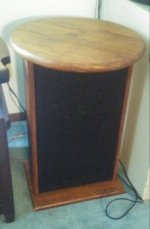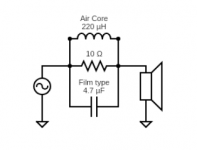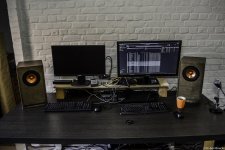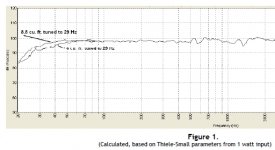I must redo my voight style speakers ,,I must add lots of lead because it's so thin, the box.
The late iteration with those Is using a 2" in 8" waveguide crossed at 1 kHz(I believe..🙄).
Nice behavior of that shallow WG, an old speaker, repurposed.It sits below the box.
The 8" woofer Is a Vifa from the '80s
The late iteration with those Is using a 2" in 8" waveguide crossed at 1 kHz(I believe..🙄).
Nice behavior of that shallow WG, an old speaker, repurposed.It sits below the box.
The 8" woofer Is a Vifa from the '80s
Last edited:
That depends. My current speakers are about 30"x18". If I needed to run without a sub it would be better to go a little bit larger. 2 to 3 feet from the back wall is best.
30" H x 18" W is certainly not obtrusive, but for me, getting the baffles 3 feet from the back wall would be a challenge. 2 feet is possible.
I should try it though. I have some Alpair drivers I could do that with.
How do you get your baffles to stand upright without falling over?
The Alpair will need some bass support of course to be truly full range. On my first experiment I just screwed side panels to the baffle making it a very shallow U. I also put a shallow Shelf on the top.
P.S. They work a little bit better when a bit farther out from the wall but work OK this way. The best they sounded is when they were in the music room with bookshelves three feet behind them and slightly toed in. The books did a great job of scattering the back wave giving a lot of space to the sound.
Attachments
Last edited:
says who?
I have also thought those Tannoy speakers sound simply dreadful.
Lousy bass, horrible shouty midrange and pretty much zilch real detailed treble.
They are 1950s technology dressed up in dandy expensive clothes.
I would beat them to a pulp in every single detail with my own home studio bespoke designed system especially linearity and proper bass response.
I agree that it's an old system, overpriced and not flat, but it does work very well for classical music. I would never buy it (way to expensive) and listen to an other system to classical music (a waw system with a 5.25" fullrange driver and 10" subwoofer powered by a medium power amp).
But that guy (my ex-"father in law") had next to it a pair of B&W 800D (original series) powered by Pass Labs amps that sounded less good for classic (but better for the rest). The B&W is too bright for classical symphonies. In the other room he also got Harbeth and Kef speakers that didn't do it that good also for classical. I spend a lot of hours there, so i know them rather well.
Last edited:
system...that plays well with intelligibility at normal volumes than a system conceived for loud sound. It goes to say that HE systems suffer from the excessive 'bigness' that characterizes HE itself
A high-efficiency system (usually horn-based) that plays well at high SPLs usually sounds only cleaner at lower levels, which is also the basis for many people having expensive PA/concert/cinema speakers at home. The "bigness" is just a property that indicates the dynamic range of the sound, which needs to be wide for realistic classical music. Thus, any excessive bigness may be easily cut down by simply using lesser amplifier power, if the speaker (whichever you choose) sounds more or less the same across a 20-23 dB dynamic range.
The thing that always amazes me is how many people talk about 'realistic sound pressure levels in the home' as if that was a [good] thing.... Most of us don't have fully isolated listening studios where we can play music with sustained 105dB peak levels ...
I guess the 105dB comes from cinema calibration standards. However, it's important to note that such peaks are reserved for the occasional dinosaur and are therefore not very frequent (though specified). The dynamic range of music is usually lesser than that of movies, but classical seems to be really close to what cinema standards specify.
And since it's the average SPL that makes things loud for people (and not the occasional peak), the lower average power (higher crest factor) of classical music is unlikely to make things very loud when compared to the other kinds (say electronic). Besides, since the dynamic range is only reduced (and never expanded) during recording / remastering for home environments, the wide 20dB range specified by cinema standards should be more than enough for proper reproduction of classical music at SPLs suitable for smaller rooms as well.
Other things such as which speaker is best etc. are highly subjective and debatable topics (from what we have already seen on forums until now).
Last edited:
I made a pair of bass reflex boxes for a pair of Alpair 10 (aluminum cones). I find they sound a bit edgy in the highs, kind of forward sounding. They don't sound as smooth as the JBL LSR305 speakers, so I suspect they don't have a flat and accurate FR. Or maybe I'm hearing cone breakup in the 10kHz to 12kHz area (which is as high as I can hear these days). They are nice sounding, and you don't notice anything wrong until you hear something better. Maybe if I add some baffle step compensation to make them sound more 'full'.
--
I use those in my office, but i use a LRC filter to tame the highs and then they are great. The filter is basicly an inductor resistor and cap in parallel with each other in series with the driver and that tames the resonance of the driver (see pic). For nearfield listening those are great speakers, but they lack a bit bass and dynamics for big classic orchestra's or organ music. In my living room i use the same driver combined with a 10" scanspeak woofer (both in sealed cabinets) with crossover at 250Hz (1st order serial) and that works much better as the driver does not have to do bass so it can handle the dynamics better.
Attachments
Lots of issues there. 1/ I dunno why high efficiency systems be horn based as they are not capable of reproducing right down where all the energy is. The only way to get that with low distortion is with large cone area.A high-efficiency system (usually horn-based) - , if the speaker (whichever you choose) sounds more or less the same across a 20-23 dB dynamic range. I guess the 105dB comes from cinema calibration standards. However, it's important to note that such peaks are reserved for the occasional dinosaur And since it's the average SPL that makes things loud for people Besides, since the dynamic range is only reduced ... during recording / remastering for home environments, the wide 20dB range specified by cinema standards should be more than enough for proper reproduction of classical music at SPLs suitable for smaller rooms as well.
2/ Large bass response is not loud which is why you are confusing SPL with fletcher munson which clearly shows the ear's non linear responses to FR.. In reality the ear is most sensitive in the range where speakers finally become efficient, making for a completely unnatural reproduction of the original. In some of the most expensive systems I have heard this effect seems to be worsened significantly.
3/ dynamic range of uncompressed live recordings shown by our own live recorded material (major opera house) is maximum about 50dB at which people complain becomes inaudible in quiet sections (go figure!). You have to compress to some extent, live music from source material or people moan about it being to loud in loud passages and too quiet in quiet passages.... Then you have the to worry about loudness wars on broadcast radio!
Last edited:
Btw I use a tweak from that guy at Tubecad which entails using multi windings and multi taps from a valve amp as a semi-active crossover. The 12inch & 15 inch speakers are in TWO MASSIVE 235L cabinets, which handle the bass only, because chokes filter it off above about 300hz.
Because bass is not directional, it means there is 2 x 12 and 2 x 15 and 470L of cab which handles the bass. so, 226 + 353 sq in of cone area. a total of 580 sq in devoted just to the bass in massive cabinets the size of large fridges!
On tests, there is ZERO tail off below 100hz, giving at least 10-15dB more sensitivity down there - ie. a more or less linear response curve fed by 170W of valve amps.
I have never heard organ music ever reproduced with such accuracy, it sound truly wonderful on any silbermann, cavaille-coll or willis good quality recording.
but you can play absolutely any music through it, including the well known opening minutes of dark side of the moon which make the concrete + brick walls & pine wood floor vibrate.
This was a system specifically designed, invented to monitor studio recordings done elsewhere.
The tweeters are old LOMO russian cinema units with massive alnico magnets - pretty much a copy of the old and outstanding Altec 288B.
Those are running off totally different windings on the OPT from the bass units, with totally independent wiring harnesses.
Good studio mics register those as still developing acoustic power at 18-28khz.
I have just ONE live recording of Ural - Yekaterinburg orchestra playing Tchaikovsky Francesca da Rimini which has a bass drum part in the finale. Not a single system before this one was ever capable of reproducing it, and even this one struggles. https://ks4.imslp.info/files/imglnks/usimg/d/d5/IMSLP41385-PMLP19413-Tchaikovsky-Op32.TimpPerc.pdf
Look at parts pages 4-6 with the tamtam thrown in too!
Because bass is not directional, it means there is 2 x 12 and 2 x 15 and 470L of cab which handles the bass. so, 226 + 353 sq in of cone area. a total of 580 sq in devoted just to the bass in massive cabinets the size of large fridges!
On tests, there is ZERO tail off below 100hz, giving at least 10-15dB more sensitivity down there - ie. a more or less linear response curve fed by 170W of valve amps.
I have never heard organ music ever reproduced with such accuracy, it sound truly wonderful on any silbermann, cavaille-coll or willis good quality recording.
but you can play absolutely any music through it, including the well known opening minutes of dark side of the moon which make the concrete + brick walls & pine wood floor vibrate.
This was a system specifically designed, invented to monitor studio recordings done elsewhere.
The tweeters are old LOMO russian cinema units with massive alnico magnets - pretty much a copy of the old and outstanding Altec 288B.
Those are running off totally different windings on the OPT from the bass units, with totally independent wiring harnesses.
Good studio mics register those as still developing acoustic power at 18-28khz.
I have just ONE live recording of Ural - Yekaterinburg orchestra playing Tchaikovsky Francesca da Rimini which has a bass drum part in the finale. Not a single system before this one was ever capable of reproducing it, and even this one struggles. https://ks4.imslp.info/files/imglnks/usimg/d/d5/IMSLP41385-PMLP19413-Tchaikovsky-Op32.TimpPerc.pdf
Look at parts pages 4-6 with the tamtam thrown in too!
Last edited:
I dunno why high efficiency systems be horn based ....
I agree that they don't have to be horns, but many are, possibly because they're are more efficient than cone drivers.
sarcastic1 said:Large bass response is not loud which is why you are confusing SPL with fletcher munson
I'm sorry for having used "dynamic range" in place of "crest factor". However, the 20dB was not based on the Fletcher's curve but the crest factor of the loudest sounds (alone), since a reasonably linear loudspeaker is expected to have a comparable performance across all power levels. Of course, the total "dynamic range" (loudest - softest sounds) of music would be much wider.
Thus, the idea was that the loudest sounds could be properly reproduced using the speaker's low distortion (at high power), while hearing the softest portions would be mostly about the soundproofing and acoustic treatments, as the system would already be linear at reduced power.
sarcastic1 said:dynamic range of uncompressed live recordings.... is about 50dB ... You have to compress to some extent.....or people moan about it being to loud in loud passages and too quiet in quiet passages.
Well, in case of pre-recorded music, the mastering/re-mastering stage is supposed to take care of the reference SPL and dynamic range (with compression if required) for the mix being prepared.
Here are some pictures that show why large speakers (and soundproofing as well) would be necessary to reproduce classical music. I had given my opinion in favour of cinema speakers based on the fact that movie content looks rather similar to the second picture.
As larger dynamic ranges mean higher peak SPLs, more efficient speakers become necessary to put out these levels from the limited power we have, naturally bringing horn speakers into the picture (unfortunately).
The picture also shows why the occasional peaks in classical music would not make it sound "too loud". However, if one thinks it's rather quiet then it clearly means that suitable dynamic range compression needs to be applied (usually already done during mastering).


As larger dynamic ranges mean higher peak SPLs, more efficient speakers become necessary to put out these levels from the limited power we have, naturally bringing horn speakers into the picture (unfortunately).
The picture also shows why the occasional peaks in classical music would not make it sound "too loud". However, if one thinks it's rather quiet then it clearly means that suitable dynamic range compression needs to be applied (usually already done during mastering).


Last edited:
Yes, even I saw something similar here:
Western Electric 555 +22 horn - YouTube
And something else, though not classical:
western electric 15A "small" SATO-Horn JBL 2420 Klipsch La Scala FOSTEX FT65H - YouTube
Western Electric 555 +22 horn - YouTube
And something else, though not classical:
western electric 15A "small" SATO-Horn JBL 2420 Klipsch La Scala FOSTEX FT65H - YouTube
Horn speakers don't work for bass and below a certain frequency range.
Anyone who has experience in orchestras will tell you the tuba and contra bassoon work with extreme colouring in their resonant frequency range, in fact this is the main attraction of the contra as an instrument.
When you compare the mid range behaviour it's also very comprehensively beaten and thrashed by a good ESL which has almost no colouration and astonishing transient response.
That also holds for any good compression driver, which don't sound any good here.
Once you get into the area above 2-3khz where most people would like to cross over a compression driver comes into its own because of the high efficiency.
That was my thinking behind using a good C-D above 3khz, taking over from a good full range dual cone at the point where that starts to display cone break up and high distortion.
On my drivers I discovered a nasty resonance at 6khz which is dialled out with a DSP.
In Feb this year we had a shoot out between Vandersteen, JBL & multiple amplifiers which took 2 weeks.
The idea was "what sounds good and why", incl can we get compressed mpg music to sound good also?
2 of the amps were valve, one being a real vintage piece with basically KT66 from about 1950, direct coupled. so no blocking distortion possible.
One was solid state, with a DAC+ preamp which could be swopped between different "valve sound" or solid state nodes.
The room was highly damped something akin to anechoic, but not so severe.
We were unanimous the JBL were no good for classical music, but good for Jazz, Rock and Techno.
The Vandersteen were useless for those, but shone for classical music.
So it was a fight of extremes, which actually were unsuprising.
Now the funny thing was, only the valve amps could allow us to connect the 4 speakers up together using various output taps of the output transformers.
When that was done, the combo of Vandersteen and JBL was great for classical, and immediately made the 1950s amp sound quite acceptable, which it really didn't for anything beforehand.
It then sounded really pretty good on heavy techo and rock, no suprise considering the PA roots of the amp.
None of them really showed anything conclusive on either THD, or FR, the 1950s amp having a roll off of about 5dB above 15khz.
The distortion on the "NEW Studio monitor" being vanishingly small, and giving almost the same power as the huge old heavy monoblocs.
What was even more suprising after lots of fiddling, was noticing a net improvement when we bi-wired all the speaker to that amp, instead of simple dual wiring for them.
This was more obvious for the old 1950s beasts.
The solid state amp sounded clear and colourless on every single test, but also showed the difference in performance of the 2 sets of speakers as with both valve amps....
Now this was the big "crunch test" of all.
I also auditioned my own design of "studio monitor" valve amp, with the same combos of music and speakers.
This showed the same clarity of the solid state amp, but something else indefinable (which is why I spent 3-4 yrs designing and building it), which was a much more "living" sound, which we could only define at certain moments as 'sheer magic".
It also passed the same barrage of tests driving the 4 speakers, showing up similar clues as the 1950 amp, and very clearly not liking having a "distorting" preamp feeding it with "euphonic" valve sound, which the solid state didn't mind so much.
Very clear conclusions were drawn, confirming my own bias for my own favoured solution, which was for a speaker array, with each little section dedicated to doing what it does best. (7 drivers in total for each front channel).
In that case it's irrelevant what music you put through it, it always sounds fantastic, but I simply haven't found a tweeter that works as well as my old "Altec clones" from Russia. (which of course are cinema drivers, eg.compare-with modern beyma).
Here are various views of bits of all this including the "idealised" Harmann curves.
We didn't totally fail in our search for the "perfect combo" for each music, but there were some things we still didn't fully understand at the end, especially after measuring everything in great details with Neumann microphones.
It was great fun, including a long debate about why the manager of the local "hi end" music shop has an auditorium which has horrible resonance problems, favoured one of my amp restorations where it's clear the sound is extremely coloured (1950s 6V6 based amp), and clearly struggled to identify uncompressed 24-96 PCM audio compared with high rate mp3, and misidentified the mp3 version as being "BETTER".
In this game you only know what you don't know, and/or struggle to explain.
When it becomes a question of money, cables, components or budget, it's clear after double blind testing, bias is obvious.
Anyone who has experience in orchestras will tell you the tuba and contra bassoon work with extreme colouring in their resonant frequency range, in fact this is the main attraction of the contra as an instrument.
When you compare the mid range behaviour it's also very comprehensively beaten and thrashed by a good ESL which has almost no colouration and astonishing transient response.
That also holds for any good compression driver, which don't sound any good here.
Once you get into the area above 2-3khz where most people would like to cross over a compression driver comes into its own because of the high efficiency.
That was my thinking behind using a good C-D above 3khz, taking over from a good full range dual cone at the point where that starts to display cone break up and high distortion.
On my drivers I discovered a nasty resonance at 6khz which is dialled out with a DSP.
In Feb this year we had a shoot out between Vandersteen, JBL & multiple amplifiers which took 2 weeks.
The idea was "what sounds good and why", incl can we get compressed mpg music to sound good also?
2 of the amps were valve, one being a real vintage piece with basically KT66 from about 1950, direct coupled. so no blocking distortion possible.
One was solid state, with a DAC+ preamp which could be swopped between different "valve sound" or solid state nodes.
The room was highly damped something akin to anechoic, but not so severe.
We were unanimous the JBL were no good for classical music, but good for Jazz, Rock and Techno.
The Vandersteen were useless for those, but shone for classical music.
So it was a fight of extremes, which actually were unsuprising.
Now the funny thing was, only the valve amps could allow us to connect the 4 speakers up together using various output taps of the output transformers.
When that was done, the combo of Vandersteen and JBL was great for classical, and immediately made the 1950s amp sound quite acceptable, which it really didn't for anything beforehand.
It then sounded really pretty good on heavy techo and rock, no suprise considering the PA roots of the amp.
None of them really showed anything conclusive on either THD, or FR, the 1950s amp having a roll off of about 5dB above 15khz.
The distortion on the "NEW Studio monitor" being vanishingly small, and giving almost the same power as the huge old heavy monoblocs.
What was even more suprising after lots of fiddling, was noticing a net improvement when we bi-wired all the speaker to that amp, instead of simple dual wiring for them.
This was more obvious for the old 1950s beasts.
The solid state amp sounded clear and colourless on every single test, but also showed the difference in performance of the 2 sets of speakers as with both valve amps....
Now this was the big "crunch test" of all.
I also auditioned my own design of "studio monitor" valve amp, with the same combos of music and speakers.
This showed the same clarity of the solid state amp, but something else indefinable (which is why I spent 3-4 yrs designing and building it), which was a much more "living" sound, which we could only define at certain moments as 'sheer magic".
It also passed the same barrage of tests driving the 4 speakers, showing up similar clues as the 1950 amp, and very clearly not liking having a "distorting" preamp feeding it with "euphonic" valve sound, which the solid state didn't mind so much.
Very clear conclusions were drawn, confirming my own bias for my own favoured solution, which was for a speaker array, with each little section dedicated to doing what it does best. (7 drivers in total for each front channel).
In that case it's irrelevant what music you put through it, it always sounds fantastic, but I simply haven't found a tweeter that works as well as my old "Altec clones" from Russia. (which of course are cinema drivers, eg.compare-with modern beyma).
Here are various views of bits of all this including the "idealised" Harmann curves.
We didn't totally fail in our search for the "perfect combo" for each music, but there were some things we still didn't fully understand at the end, especially after measuring everything in great details with Neumann microphones.
It was great fun, including a long debate about why the manager of the local "hi end" music shop has an auditorium which has horrible resonance problems, favoured one of my amp restorations where it's clear the sound is extremely coloured (1950s 6V6 based amp), and clearly struggled to identify uncompressed 24-96 PCM audio compared with high rate mp3, and misidentified the mp3 version as being "BETTER".
In this game you only know what you don't know, and/or struggle to explain.
When it becomes a question of money, cables, components or budget, it's clear after double blind testing, bias is obvious.
Attachments
-
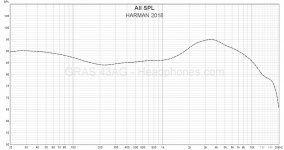 Harman_2018.jpg115 KB · Views: 275
Harman_2018.jpg115 KB · Views: 275 -
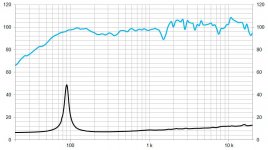 beyma-speakers-graph-full-range-12GA50.jpg76.5 KB · Views: 244
beyma-speakers-graph-full-range-12GA50.jpg76.5 KB · Views: 244 -
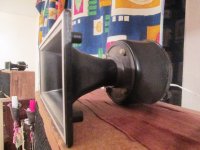 crazy_1396.jpg152.9 KB · Views: 260
crazy_1396.jpg152.9 KB · Views: 260 -
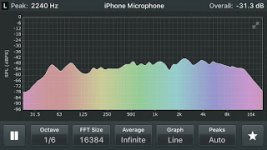 Altec Symbiotik.jpg17.6 KB · Views: 254
Altec Symbiotik.jpg17.6 KB · Views: 254 -
 mf_hf_studio.jpg100.8 KB · Views: 249
mf_hf_studio.jpg100.8 KB · Views: 249 -
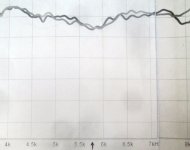 6k_notch.jpg180.1 KB · Views: 72
6k_notch.jpg180.1 KB · Views: 72 -
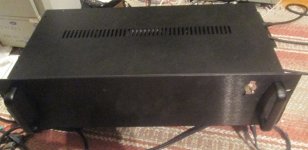 A3_front.jpg130.1 KB · Views: 89
A3_front.jpg130.1 KB · Views: 89 -
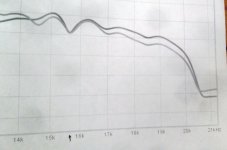 lomo_HF.jpg188.3 KB · Views: 85
lomo_HF.jpg188.3 KB · Views: 85
Last edited:
Quote
"Horn speakers don't work for bass and below a certain frequency range.
Anyone who has experience in orchestras will tell you the tuba and contra bassoon work with extreme colouring in their resonant frequency range, in fact this is the main attraction of the contra as an instrument.
When you compare the mid range behaviour it's also very comprehensively beaten and thrashed by a good ESL which has almost no colouration and astonishing transient response."
Well I have experience in orchestras, and I would like to make a few observations.
Most classical music does not have contra bassoon or tuba. That that does, those instruments are not regularly playing. When those instruments actually do play they are usually playing the bass of groups of instruments; trombones, [or with uncommon Wagner Tubas], in the case of the Tuba. I cannot say that there is anything special about the timbre of the lower notes of the tuba or contra. They are just very low frequencies.
If it was necessary to reproduce 30Hz at equal amplitude at high levels it would be a waste of time for anyone to listen to classical music on Quad ESLs. A speaker that for some real enthusiasts I know is the gold standard for reproduction.
As possibly an irrelevance, I do not personally know a single classical musician who listens at anything remotely approaching "realistic" levels.
"Horn speakers don't work for bass and below a certain frequency range.
Anyone who has experience in orchestras will tell you the tuba and contra bassoon work with extreme colouring in their resonant frequency range, in fact this is the main attraction of the contra as an instrument.
When you compare the mid range behaviour it's also very comprehensively beaten and thrashed by a good ESL which has almost no colouration and astonishing transient response."
Well I have experience in orchestras, and I would like to make a few observations.
Most classical music does not have contra bassoon or tuba. That that does, those instruments are not regularly playing. When those instruments actually do play they are usually playing the bass of groups of instruments; trombones, [or with uncommon Wagner Tubas], in the case of the Tuba. I cannot say that there is anything special about the timbre of the lower notes of the tuba or contra. They are just very low frequencies.
If it was necessary to reproduce 30Hz at equal amplitude at high levels it would be a waste of time for anyone to listen to classical music on Quad ESLs. A speaker that for some real enthusiasts I know is the gold standard for reproduction.
As possibly an irrelevance, I do not personally know a single classical musician who listens at anything remotely approaching "realistic" levels.
I use those in my office, but i use a LRC filter to tame the highs and then they are great. The filter is basicly an inductor resistor and cap in parallel with each other in series with the driver and that tames the resonance of the driver (see pic). For nearfield listening those are great speakers, but they lack a bit bass and dynamics for big classic orchestra's or organ music. In my living room i use the same driver combined with a 10" scanspeak woofer (both in sealed cabinets) with crossover at 250Hz (1st order serial) and that works much better as the driver does not have to do bass so it can handle the dynamics better.
Very much like my Alpair 10 cabs, except yours are far prettier, and undoubtedly made better.
Did you make those cabs from the plans on planet10's site?
Thanks for the notch filter schematic, I'll try it.
Do you use that same notch filter in the living room setup (with the 250Hz crossover)?
Horn speakers don't work for bass
Not categorically true, unless you have home theater predilections for what "bass" means. (Home theater buffs like their subwoofers to respond below 20Hz, while music listeners really don't need that unless they're into playing audiophile recordings of cathedral pipe organs. Lowest fundamental of a bass viol is 40Hz, unless you count the low C of a bass with a C extension, so that would be closer to 30Hz.)
Example of a domestic horn system that makes bass (if you're OK with F3 of 45Hz or so) = Klipschorn (corner horn, so you must place it in a corner, or no bass)
(Edit to add: I wouldn't call the Klipschorn the be-all-and-end-all of domestic horn systems, though. Response anomalies abound -- Klipsch Klipschorn AK6 loudspeaker Measurements | Stereophile.com)
and below a certain frequency range.
True. The horn won't load the driver below a certain frequency.
--
Last edited:
Very much like my Alpair 10 cabs, except yours are far prettier, and undoubtedly made better.
Did you make those cabs from the plans on planet10's site?
Thanks for the notch filter schematic, I'll try it.
Do you use that same notch filter in the living room setup (with the 250Hz crossover)?
No, designing is half the fun for me so i did my own design that you can find here: Dropbox - Mark-Audio-Alpair-10M-Slot-Ported-Official-CAD-drawings.pdf - Simplify your life. I never build kits for myself, only for others on request (and paid).
And i use the same filter in the big setup indeed, it's not really cabinet depending this, this is purely to tame the resonances in the top of the response of the driver outside the band that is affected by the cabinet design. so it's rather universal for this driver.
Quote
If it was necessary to reproduce 30Hz at equal amplitude at high levels it would be a waste of time for anyone to listen to classical music on Quad ESLs.
A speaker that for some real enthusiasts I know is the gold standard for reproduction.
well yes it is a waste of time listening to classical music on QUAD ESLs, (ON THEIR OWN) because they are incapable of recreating bass.
Gold standard of what?
Going into overload protection at the slightest whim?
Best is to go back to the inventors of ESL and see what really constitutes a gold standard, and it's not hearsay> The KLH Nine.

If you want something useable from QUADs you have to use an extra bass cabinet for reinforcement, and that is from the horse's mouth (Schneider).
As for recreating bass, it's got nothing to do with "equal amplitude" because all speakers apart from some very rare drivers roll off the bass by at least 5-7dB per octave below 90hz.
(Almost the only ones that don't are studio monitors like great-plains-audio, derived from Altec).
See graph of the 15" unit. 98dB at 1W at 40hz....and only about -1dB down dropping only about 2dB more at 30hz.
It makes Tannoy look the really weak out of date stuff it really is.
I arrived at a solution where the bass simply doesn't roll off, which is similar in some ways to Altec, because by accident or design I used the recommended size of cabinet they do
As for orchestral musicians and their levels, don't kid me.
Most of them simply can't tell the difference between high or low quality sound, because they invariably listen to stuff on in ear, ear phones driven by mp3 or AAC at bit rates rarely exceeding 128kb/s, and can't tell you blind if an A played to them is anything between 439 to 442hz.
(I did that blind test and was shocked!).
Attachments
Last edited:
well, in my sound engineering days i worked quiet a few times as assistant for classical recordings done in Belgium and surrounding countries, and mostly i saw B&W 800 or 801 models be used by the recording and mixing engineer i had to assist. Those were modded to tame the tweeter i was told. Amps were mostly Bryston. Sometimes they also used Klein & Hummel o300's or ATC's as nearfield, but almost always with the B&W's to check the final mix as that speaker was the benchmark of the production crew.
And often it was my task to run trough the space with the microphone on a stand while the engineer was in the controlroom listening and saying where to go or how to adjust the stand untill he found the sweetspot for that microphone. Mostly used was an x/y setup up front, a pair microphones hanging from above and maybe a close mic for the solist (depending on the instrument and the way it was played). All were "Schoeps CMC" modular small membrane condensors.
I'm not sure if it's still the same today (as that sector is very conservative), but 15 years ago or longer it was like that over here.
And often it was my task to run trough the space with the microphone on a stand while the engineer was in the controlroom listening and saying where to go or how to adjust the stand untill he found the sweetspot for that microphone. Mostly used was an x/y setup up front, a pair microphones hanging from above and maybe a close mic for the solist (depending on the instrument and the way it was played). All were "Schoeps CMC" modular small membrane condensors.
I'm not sure if it's still the same today (as that sector is very conservative), but 15 years ago or longer it was like that over here.
"Those were modded to tame the tweeter i was told."
Current 800/801 are still decent speakers except tweeter is apparently exaggerated most probably due to marketing reasons. I don't know why 801 has become standard for classical recordings, Possibly the only decent speakers made in Europe was 801 in 80s? It was before Genelec era. In my impression , those large Geithain would be a really good speaker for classical monitor today.
Current 800/801 are still decent speakers except tweeter is apparently exaggerated most probably due to marketing reasons. I don't know why 801 has become standard for classical recordings, Possibly the only decent speakers made in Europe was 801 in 80s? It was before Genelec era. In my impression , those large Geithain would be a really good speaker for classical monitor today.
- Home
- Loudspeakers
- Multi-Way
- What high efficiency speaker for Classical Music ?
